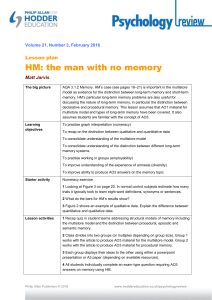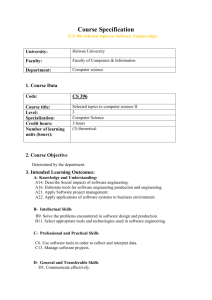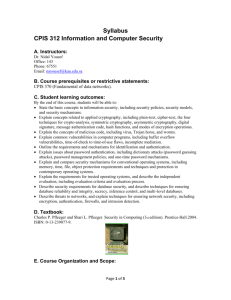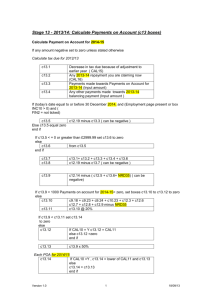Information systems
advertisement
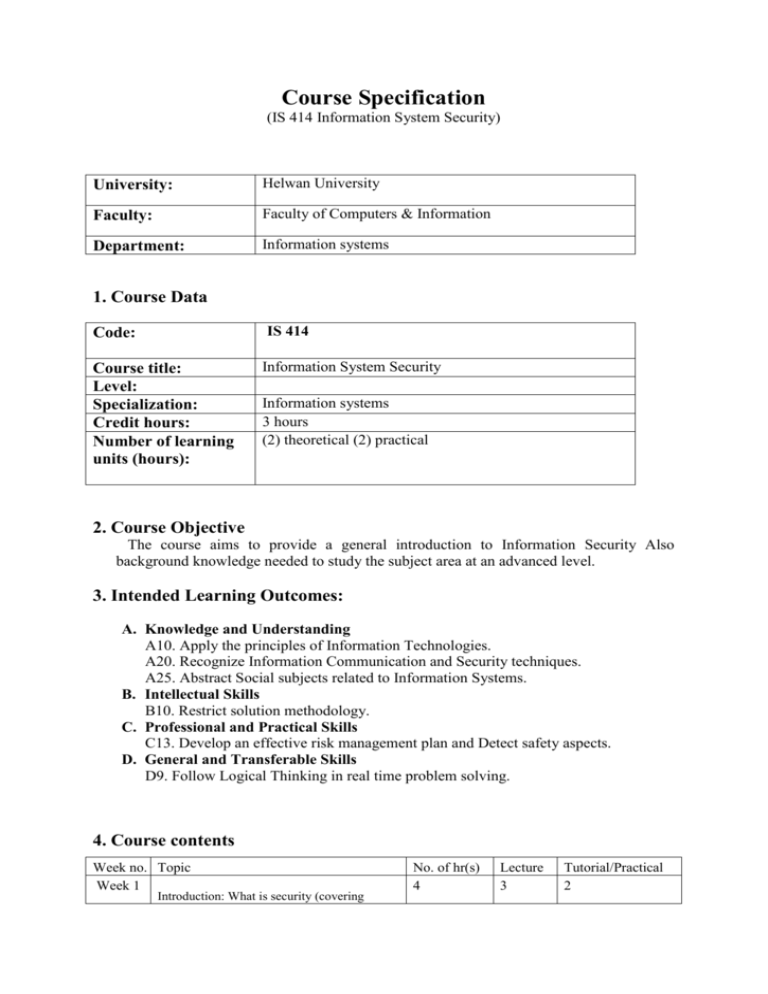
Course Specification (IS 414 Information System Security) University: Helwan University Faculty: Faculty of Computers & Information Department: Information systems 1. Course Data IS 414 Code: Course title: Level: Specialization: Credit hours: Number of learning units (hours): Information System Security Information systems 3 hours (2) theoretical (2) practical 2. Course Objective The course aims to provide a general introduction to Information Security Also background knowledge needed to study the subject area at an advanced level. 3. Intended Learning Outcomes: A. Knowledge and Understanding A10. Apply the principles of Information Technologies. A20. Recognize Information Communication and Security techniques. A25. Abstract Social subjects related to Information Systems. B. Intellectual Skills B10. Restrict solution methodology. C. Professional and Practical Skills C13. Develop an effective risk management plan and Detect safety aspects. D. General and Transferable Skills D9. Follow Logical Thinking in real time problem solving. 4. Course contents Week no. Topic Week 1 Introduction: What is security (covering No. of hr(s) 4 Lecture 3 Tutorial/Practical 2 notions of Confidentiality, Integrity, and Availability)? 4 3 2 4 3 2 4 3 2 4 3 2 4 3 2 4 3 2 Week 8 Biometric techniques. Use of tokens (dumb and 4 3 2 Week 9 intelligent), smart cards Network security concepts: Security services and security mechanisms (as in ISO 7498--2). 4 3 2 4 3 2 4 Week 11 Using authentication protocols for key distribution, 3 2 3 2 Week 2 Week 3 Week 4 Week 5 Week 6 Week 7 Security threats and risks. Security management (the DTI code of practice). The Data Protection Act. Elements of cryptography: Ciphers (DES). Authentication codes (MACs). Public key ciphers and digital signatures (RSA). Access control: Access Control Lists, capabilities, security label, role-based access control. Database security: The access path, views for security, integrity controls Personal computer security: Viruses, restricting access. Identity verification: Use and storage of conventional passwords. Dynamic password schemes. Authentication and key distribution: Key management and entity authentication in a network. Week 10 Objectives of an entity authentication protocol. Some fundamental protocols (e.g. Kerberos). and other approaches to key establishment (including public key certificates and X.509). Firewalls Week 12 Topic 4 Security standards bodies: Introduction to roles of ISO, ITU, CEN, ETSI and BSI. The main roles of ISO/IEC SC21 and SC27 and a brief introduction to (security related) standards. Mapping contents to ILOs Intended Learning Outcomes (ILOs) Knowledge and Knowledge Knowledge understanding and and understanding understanding Knowledge and understanding Introduction: What is security (covering notions of Confidentiality, Integrity, and Availability)? A10,A25 Security threats and risks. Security management (the DTI code of practice). The Data Protection Act. Elements of cryptography: Ciphers (DES). Authentication codes (MACs). Public key ciphers and digital signatures (RSA). Access control: Access Control Lists, capabilities, security label, role-based access control. A20,A25 Database security: The access path, views for security, integrity controls B10 C13 D9 B10 C13 D9 B10 C13 D9 B10 C13 D9 B10 C13 D9 Personal computer security: Viruses, restricting access. A10 B10 C13 Identity verification: Use and storage of conventional passwords. A20 B10 C13 D9 A25 B10 C13 D9 B10 C13 D9 C13 D9 Dynamic password schemes. Biometric techniques. Use of tokens (dumb and intelligent), smart cards Network security concepts: Security services and security mechanisms (as in ISO 7498-2). Authentication and key distribution: Key management and entity authentication in a network. Objectives of an entity authentication protocol. Some fundamental protocols (e.g. Kerberos). Using authentication protocols for key distribution, and other approaches to key establishment (including public key certificates and X.509). Firewalls D9 Security standards bodies: Introduction to roles of ISO, ITU, CEN, ETSI and BSI. The main roles of ISO/IEC SC21 and SC27 and a brief introduction to (security related) standards. A20 C13 5. Teaching and Learning Methods Lectures Exercises Lab Work (Unix security) 6. Teaching and Learning Methods for students with limited capability Using data show e-learning management tools 7. Students Evaluation a) Used Methods Written exams for the security concepts Project Security for a LAN Internet Privacy Enhanced Mail (PEM). Presentation b) Time Assessment 1 Week 3 Assessment 2 Week 5 c) Grades Distribution Mid-Term Examination Final-term Examination Oral Examination. Practical Examination Semester Work and Project Other types of assessment Total List of Books and References a) Notes 20% 50% % 20% 10% % 100% Course Notes b) Mandatory Books - D. Gollmann: Computer Security, John Wiley & Sons, 2nd Edition (Nov 2005) ISBN-10: 0470862939 - C.P. Pfleeger: Security in Computing, 2nd edition, 1997: ISBN-10: 0133374866 - Ross Anderson: Security Engineering, 2000: ISBN-10: 0470068523 - B. Schneier: Applied cryptography, 2nd edition, 1996: ISBN-10: 0471117099 c) Suggested Books - W. Stallings: Cryptography and network security - principles and practice, 3rd edition, 2002, ISBN10: 0130914290 / 4th edition, 2006, ISBN-10: 0131873164 d) Other publications - http://www.sqlmag.com/ Course Coordinator: Dr. Mona Nasr Chairman of the Department: Prof. Dr. Yehia Helmy
